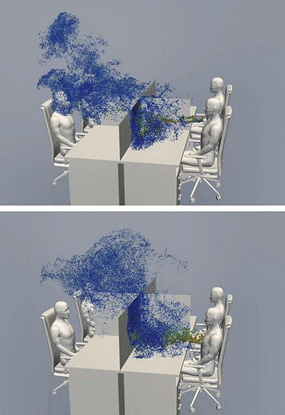
ここからコンテンツです。

Pick Up
Tackling the challenges of the COVID-19 reality
- Predicting virus droplet infection in indoor environments using the world's fastest supercomputer "Fugaku"
- Mapping the social impact of COVID-19 using social media
Predicting virus droplet infection in indoor environments using the world's fastest supercomputer "Fugaku"

RIKEN (Institute of Physical and Chemical Research), in collaboration with MEXT (Ministry of Education, Culture, Sports, Science and Technology), has been providing the computational resources of the world's fastest supercomputer "Fugaku" (named after Mt. Fuji) to accelerate research and development that will contribute to countermeasures against COVID-19.
Professor Akiyoshi Iida and Assistant Professor Tsukasa Yoshinaga of the Department of Mechanical Engineering of Toyohashi University of Technology, as members of the research team of RIKEN, are making a significant contribution to the "Prevention and countermeasures of virus droplet infection in indoor environments" by using the supercomputer for simulations.
- RIKEN Channel: Prediction of virus droplet infection in indoor environments and its countermeasures (Japanese)
- The Asahi Shimbun: Supercomputer deduces partition height to prevent virus spread
Mapping the social impact of COVID-19 using social media
Assistant Professor Mitsuo Yoshida of the department of Computer Science and Engineering of Toyohashi University of Technology, has undertaken an analysis of tweets on the Twitter, in order to examine how COVID-19 has become a social topic, how it is being debated and how it is affecting people.
A study analyzing Twitter users tweets relating to COVID-19 clarified that February 28, 2020, when the first cases of coronavirus were reported in Japan and a state of emergency was declared in Hokkaido marked a crossroads moment. Whereas prior to that moment corona related tweets had only been found among specific communities ( a small number of biased users), after that point such tweets became commonplace across the wider Twitter community (the end of user bias). Another study of about 186 million COVID-19-related tweets on Twitter from January to early June found that the biggest peak in the expression of negative emotions such as "scary" and "disgusting" occurred immediately after Ken Shimura's death at the end of March.
Studying emotional words included in tweets to analyze how people feel about the COVID-19 showed how the occurrence of a particular social event can change the emotions expressed on social media. Data obtained through this kind of study may help to clarify the change in people's emotions and could be a useful resource for future decisions on infection prevention measures.
ここでコンテンツ終わりです。
